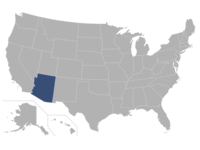Budget deficit estimate shrinks, but still is $1.3 billion

There’s a bit of good news as negotiations on state spending between GOP leaders and Gov. Katie Hobbs have begun in earnest: The state’s projected budget deficit is about $400 million less than it was three months ago, thanks to an uptick in revenue.
That’s according to the budget analysts at the Joint Legislative Budget Committee, which gave a much anticipated forecast when the Finance Advisory Committee met on April 11.
The panel of state and local economists meets three times a year, and the annual April meeting is generally seen as the most important for crafting a state budget, as it typically comes as budget talks are intensifying. That’s the case this year, as the Republican-led legislature this month has been working just one day per week — every Wednesday — to free up leaders and legislative staff to meet with Hobbs’ team in order to hammer out a budget deal.
Last week, JLBC analysts said that they now estimate the state budget is only $1.3 billion in the red — $650 million in the current fiscal year, which ends in June, and $676 million for the upcoming fiscal year. That’s less than in January, the last time the Finance Advisory Committee met, when JLBC pegged the shortfall at $1.7 billion.
“All else being equal, the overall picture has improved by about $400 million,” said JLBC Director Richard Stavneak. “But we’ve still got a problem.”
As Stavneak explained to the panel, lawmakers will actually need to solve for a larger deficit. That’s because Republican leaders want to ensure the upcoming year’s budget ends with a $100 million balance and there is nearly $370 million in spending that is categorized as one-time expenses that must be included in the budget, in some cases because of litigation.
Those “ongoing one-time” expenses include money for school building repairs, operating costs at state prisons and subsidies for the state employee health insurance trust fund.
And deficits are still projected through the end of the three-year budgeting window required under state law, meaning lawmakers are expected to be dealing with shortfalls through at least the fiscal year that ends in 2027.
In January, Stavneak explained that the “primary culprit” behind the shortfall is a precipitous drop in individual income tax collections — largely due to the full implementation of the state’s flat tax in 2023. In 2021, GOP lawmakers and then-Gov. Doug Ducey changed Arizona income taxes from a graduated tax rate to a flat tax, a move that budget analysts said would cost the state about $1 billion in revenue from 2021 levels when they were fully implemented.
That full implementation happened this year, and the result is the bottom falling out of income tax collections.
Additionally, spending on a universal private school voucher program was much higher than initially expected
Last year, when lawmakers approved the current year’s budget, they expected the flat income tax would slash $2.3 billion from state revenues. But the drop-off has been much worse than anticipated, and individual income tax collections are already $481 million less than projected.
The reason the deficit is shrinking is because revenues have been trending upward since January, when JLBC revised revenue estimates sharply downward. (A mid-year revision happens every year in January.) Since then, revenues are estimated to be $185 million more than that forecast.
Budget analysts said there are two main drivers to the improvements: income tax refunds are less than expected and tax collections on insurance premiums are up by about 12% over last year. Meanwhile, sales tax collections, which typically drives changes in state revenues, are sluggish, particularly in the retail sector.
Republican legislators and Hobbs remain at odds over both how to tackle the deficit and the actual size of the budget shortfall. The governor in January has estimated the problem is only about half the size that JLBC projected, though her office has not released any new figures since then.
In January, Hobbs proposed addressing the deficit largely through a combination of clawing back money that has been appropriated for one-time ventures — many of them road and highway projects inserted into the budget by Republicans — drastically reforming the state’s private school vouchers to remove about 50,000 students from the program and eliminating a private school scholarship tax credit. Those ideas have already been declared dead on arrival by Republican lawmakers.
The baseline budget from which legislators will start crafting a spending plan scraps $2.3 billion of the $2.9 billion in one-time spending in the current year’s budget, much of which was for highway projects that don’t require multiple years of funding. But with increased formula spending on education and health care, the baseline spending is only $1.5 billion less than the current year.








